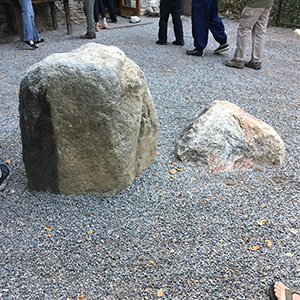- October 22, 2019 @ 6:45 pm – 8:15 pm
 If the San Francisco Zen Center is the Suzuki Soto Zen mothership, Tassajara is a very close daughter as well as dharma sister to Green Gulch (the third of this close zen family). Tassajara is largely off the grid, hours and miles from most anything except the steep forested mountains that surround it and drain off into the cold rocky creek running along this zen valley village.
If the San Francisco Zen Center is the Suzuki Soto Zen mothership, Tassajara is a very close daughter as well as dharma sister to Green Gulch (the third of this close zen family). Tassajara is largely off the grid, hours and miles from most anything except the steep forested mountains that surround it and drain off into the cold rocky creek running along this zen valley village.
Being there provides a sense that AZC is a member of that family; and of how AZC connects to shared traditions. In off-the-grid Tassajara, things seem closer to origins. Our alarm clock was a guy with a hand bell running by the cottages and up and down all the paths at 5:30. In the morning. Imagine sitting for zazen in the (very) dark, (very) cold morning and hearing the strike of the zendo han wood on wood responded to by the han further away at the Abbot’s residence in the forest village: “We are here. Are you there?” “Yes. We are here.” “Great. See you soon.” “On our way.” Several minutes later the crunch of gravel on the path gets louder, then footsteps down the exterior zendo walkway are followed by the swish of robes as the priest enters the zendo. “Oh,” you might think before returning to count your breath, “that’s where the han strikes (…and other bell, gongs, drums and rituals) at AZC came from. It’s more than cool. In this setting the rituals feel profound and welcoming.
 “The Austin Group” (as they called us), were quickly integrated, assuming our roles as dishwashers, toilet cleaners, gardeners or construction workers based on our skill sets and needs at hand. Besides dishes and toilets, Mako was invited right back into leadership roles at Tassajara, running work meetings, leading zazen and services, meeting with students, workers and others. It was clear that Mako was highly respected, welcomed and quickly re-integrated back into the community and its traditions. We met, visited with, and worked beside priests from San Francisco; those who worked with Norman Fisher or Reb Anderson; and others who resided at Tassajara including our friend Jonathan Riley.
“The Austin Group” (as they called us), were quickly integrated, assuming our roles as dishwashers, toilet cleaners, gardeners or construction workers based on our skill sets and needs at hand. Besides dishes and toilets, Mako was invited right back into leadership roles at Tassajara, running work meetings, leading zazen and services, meeting with students, workers and others. It was clear that Mako was highly respected, welcomed and quickly re-integrated back into the community and its traditions. We met, visited with, and worked beside priests from San Francisco; those who worked with Norman Fisher or Reb Anderson; and others who resided at Tassajara including our friend Jonathan Riley.
Seeing first-hand how the AZC community and our leader belonged to and were integrated within the larger Suzuki family, its teachings and traditions provided a profound practice anchor. Now I know that what AZC does in Austin is not based on what’s trendy or trending; or based on personalities, or revenue generation. The heart of AZC connects us to this larger special family and Suzuki tradition and the deep roots of practice. We are a branching stream connected at the source.
Share this:
- Click to email a link to a friend (Opens in new window) Email
- Click to share on Facebook (Opens in new window) Facebook
- Click to share on Telegram (Opens in new window) Telegram
- Click to share on Bluesky (Opens in new window) Bluesky
- Click to share on X (Opens in new window) X
- Click to share on LinkedIn (Opens in new window) LinkedIn
